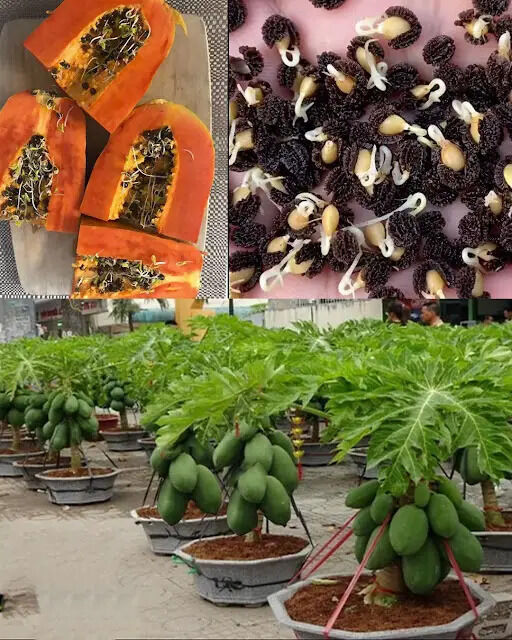ADVERTISEMENT
It’s important to note that papayas are generally male, female, or hermaphrodite, and you need at least one hermaphrodite or a combination of male and female plants to ensure pollination. If you’re growing multiple plants, be sure to select one or more hermaphrodite papayas, as they can produce fruit on their own.
Step-by-Step Guide to Growing Papaya in Pots
- Choose the Right Pot
Papayas need plenty of space to grow their roots, so select a large, sturdy pot with good drainage. A 5-gallon pot is a good starting point for a young plant, but larger containers (10–15 gallons) will be needed as the tree matures. Ensure the pot has drainage holes to avoid waterlogging. - Pick the Right Soil
Papayas love well-draining, loamy soil. You can either buy a pre-mixed potting soil designed for tropical plants or make your own by combining regular potting soil with perlite or sand to improve drainage. If you’re using heavy soil, amend it with organic compost to help improve fertility. - Planting Your Papaya Seedling
You can start papayas from seeds, but it’s often quicker and easier to buy a young plant from a nursery. When planting, dig a hole that’s just big enough for the root ball, and gently place the plant in the pot. Make sure the top of the root ball is level with the surrounding soil to avoid burying the stem too deeply. - Provide Ample Sunlight
Papayas are sun-loving plants, so make sure your pot is placed in a spot that gets plenty of bright sunlight—ideally, 6 to 8 hours a day. A south-facing patio, balcony, or garden area is often perfect. If you live in a region with cold winters, consider moving your papaya indoors or using a greenhouse during the colder months. - Watering
Papayas need consistent moisture, but they don’t like to sit in water. Water your plant regularly, especially during dry spells, but be sure the pot drains well. Check the soil moisture before watering; the soil should be moist but not soggy. During the growing season, water more frequently, and reduce watering during the dormant months (fall and winter). - Fertilize Regularly
To encourage healthy growth and fruiting, papayas need regular feeding. Use a balanced fertilizer, preferably one that’s high in nitrogen during the growing season to promote leaf growth. When the plant starts producing fruit, switch to a fertilizer that’s higher in potassium and phosphorus to support fruit development. Organic compost can also be used to enrich the soil. - Prune and Support Your Plant
Papayas don’t require much pruning, but you can remove dead or damaged leaves to keep the plant healthy. As papayas grow tall, they may need some support to prevent them from toppling over in the wind. Use a stake or trellis to support the stem if necessary, especially if you’re growing a taller variety. - Watch for Pests and Diseases
Papayas can be susceptible to pests like aphids, whiteflies, and spider mites. Keep an eye on your plant for any signs of pest damage, such as yellowing leaves or sticky residue. Neem oil or insecticidal soap can help control most pests. Also, make sure the plant has good airflow to reduce the risk of fungal diseases, which can affect papayas in humid conditions.
Harvesting Your Papayas
Papayas typically start producing fruit within 9 to 12 months from planting, but this can vary depending on the variety and growing conditions. The fruit will mature from green to yellow as it ripens. You can harvest papayas when they start to turn yellow, and they’ll continue to ripen off the plant. If you’re in a cooler climate, it might take a little longer for the fruits to mature.
The key to harvesting papayas is to be patient—fruit that’s picked too early won’t have the sweet, delicious flavor that ripe papayas are known for. To test if your papaya is ready, gently press the skin with your fingers. If it gives slightly, it’s time to harvest!
Tips for Success
- Temperature: Papayas thrive in warm temperatures between 70-85°F (21-29°C). Avoid placing your pots in areas with frequent temperature fluctuations, like near air conditioning units or drafty windows.
- Container Size: The larger the pot, the better. A bigger pot allows the roots to spread out and grow, which leads to a healthier, more productive plant.
- Be Patient: Papayas can take time to mature, so don’t expect instant results. With proper care, however, you can enjoy fresh papayas from your own plant in no time.
Conclusion: Your Own Papaya Paradise
Growing papayas in pots at home is a rewarding experience that can yield delicious fruit with the right care and attention. Whether you’re a seasoned gardener or a beginner, cultivating a papaya tree in a pot is an achievable goal that can bring a little tropical flavor to your backyard or balcony. With the right conditions—sunlight, watering, and proper nutrients—you’ll soon be enjoying an abundant harvest of fresh, homegrown papayas.
So why not give it a try? The secret to success is just a pot, a seedling, and a little patience, and before you know it, you’ll be savoring the fruits of your labor!
ADVERTISEMENT
ADVERTISEMENT
